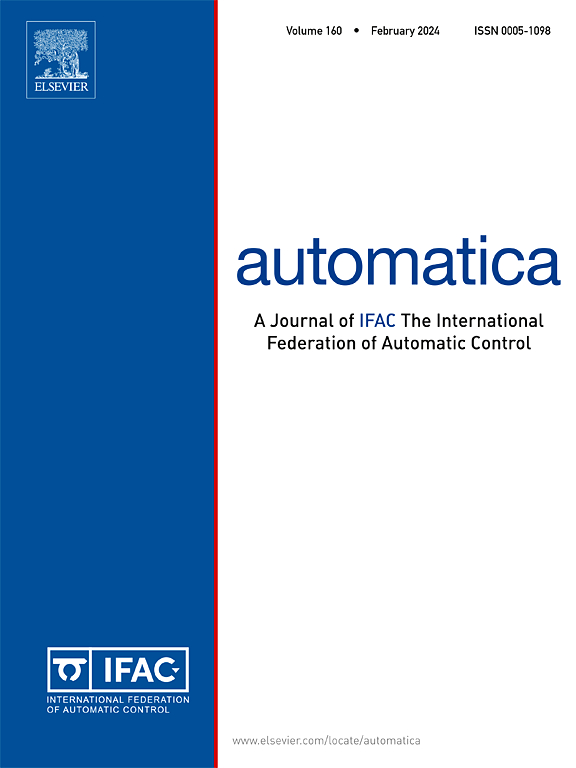具有饱和输出观测和一般输入条件的大型模型的估计和预测
IF 4.8
2区 计算机科学
Q1 AUTOMATION & CONTROL SYSTEMS
引用次数: 0
摘要
研究了具有饱和输出观测值的大型模型的估计和预测问题。这里的大模型是指具有大量或无限数量的未知参数的模型。即使对于输出观测值为饱和或二值的有限维线性随机系统,也有必要研究这种模型,因为传统参数估计算法中使用的回归量由于输出信号的部分观测值而不可用。我们将提出一种两步投影递归估计算法,并分析在不排除强相关反馈信号的弱激励条件下输入信号的全局收敛性和收敛速率。此外,在不使用任何激励条件的情况下,通过分析累积遗憾的渐近上界,建立了预测的准确性。本文可以看作是对最近建立的具有饱和输出观测值的有限维随机回归模型的结果的推广,但新的结果也可以用于解决不使用大模型很难解决的有限维估计问题。本文中对大型模型进行理论分析的关键技术之一是作者提出的双阵鞅理论。本文还提供了一个基于司法经验数据的案例研究。本文章由计算机程序翻译,如有差异,请以英文原文为准。
Estimation and prediction for large models with saturated output observation and general input condition
This paper considers the estimation and prediction problems for large models with saturated output observations. Here large models are referred to models with a large or infinite number of unknown parameters. The investigation of such models appears to be necessary even for finite dimensional linear stochastic systems when the output observations are saturated or binary-valued, since the regressors used in the traditional parameter estimation algorithms are not available due to partial observations of the output signals. We will propose a two-step projected recursive estimation algorithm and analyze the global convergence and the convergence rate under quite weak excitation conditions on the input signals, which do not exclude strongly correlated feedback signals. Moreover, the accuracy of prediction is also established by analyzing the asymptotic upper bound of the accumulated regret without resorting to any excitation conditions. This paper can be regarded as an extension of the recent results established for finite dimensional stochastic regression models with saturated output observations, but the new results can also be used to solve finite dimensional estimation problems that can hardly be solved without using large models. One of the key techniques used in the theoretical analysis for large models in the current paper is the theory of double array martingales developed by one of the authors. A case study based on judicial empirical data is also provided.
求助全文
通过发布文献求助,成功后即可免费获取论文全文。
去求助
来源期刊

Automatica
工程技术-工程:电子与电气
CiteScore
10.70
自引率
7.80%
发文量
617
审稿时长
5 months
期刊介绍:
Automatica is a leading archival publication in the field of systems and control. The field encompasses today a broad set of areas and topics, and is thriving not only within itself but also in terms of its impact on other fields, such as communications, computers, biology, energy and economics. Since its inception in 1963, Automatica has kept abreast with the evolution of the field over the years, and has emerged as a leading publication driving the trends in the field.
After being founded in 1963, Automatica became a journal of the International Federation of Automatic Control (IFAC) in 1969. It features a characteristic blend of theoretical and applied papers of archival, lasting value, reporting cutting edge research results by authors across the globe. It features articles in distinct categories, including regular, brief and survey papers, technical communiqués, correspondence items, as well as reviews on published books of interest to the readership. It occasionally publishes special issues on emerging new topics or established mature topics of interest to a broad audience.
Automatica solicits original high-quality contributions in all the categories listed above, and in all areas of systems and control interpreted in a broad sense and evolving constantly. They may be submitted directly to a subject editor or to the Editor-in-Chief if not sure about the subject area. Editorial procedures in place assure careful, fair, and prompt handling of all submitted articles. Accepted papers appear in the journal in the shortest time feasible given production time constraints.
 求助内容:
求助内容: 应助结果提醒方式:
应助结果提醒方式:


